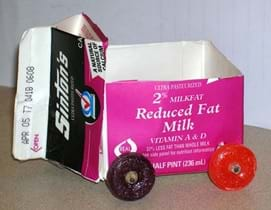Quick Look
Grade Level: Elementary school
Time Required: 45 minutes
Expendable Cost: US $1.00
Group Size: 2
Subject Areas: Geometry, Measurement, Physical Science, Problem Solving, Reasoning and Proof
Introduction
Bolded words are vocabulary and concepts to highlight with students during the activity.
An important challenge that engineers face is moving materials from their sources to construction sites. Transporting large and heavy materials over mountainous or sandy terrain can be difficult and costly. Even on site, it can still be tricky, and sometimes risky, to move materials to exactly where they are needed—for example lifting heavy materials to the top floor of a building under construction. Engineers often incorporate simple machines* into their designs of real-world transport methods to efficiently and safely move cumbersome building materials to construction sites and locations within construction sites.
*Note: The six simple machines are lever, wheel and axle, pulley, inclined plane, wedge, and screw.
Supplies
To share with the entire class:
- wheel materials: CDs, LifeSavers® mint candies, straws, coins, etc.
- body materials (disposable containers): empty milk cartons, empty soda bottles, Styrofoam bowls and cups, to-go boxes, etc.
- axle materials: dowels, straws, pencils, etc.
- miscellaneous decorating materials: construction paper, paper, string, craft sticks
- building supplies: tape, glue, scissors, rulers
- rocks/gravel (to be "transported" via the devices)
- blank paper
Subscribe
Get the inside scoop on all things TeachEngineering such as new site features, curriculum updates, video releases, and more by signing up for our newsletter!Procedure
Procedures Overview
Students use simple machines to transport materials across their classroom.
Procedure
- Organize the students into pairs.
- Read the Introduction section to students, and explain that their goal is to build a device that can efficiently move rocks from one side of the room to another and then expel them from the device. (Note: Instructors, a real-world example is a dump truck that can carry and then dump. Tell students that their devices do not need to be able to pick up the rocks.)
- Instruct students that they must utilize at least two of the simple machines: 1) wheel and axle and 2) lever, in their challenge. Remind them that there are numerous possibilities for each of these—so get creative!
- Show students the available materials. Then give them sheets of paper and have them brainstorm and sketch designs.
- Inform students that they must check their designs with the instructor before they start building. Make sure they have a way to get the rocks from one side of the room to the other, and that they can dump the load.
- Once sketches are approved, have them begin building (15 minutes).
- After 15 minutes, have groups test their devices. Instruct them to test them a few times and make changes to the designs as needed.
- Allow time at the end of the class so that each team can show its device and demonstrate how it works.
Wrap Up - Thought Questions
- What method did your team use to dump the rocks? How might this work in a real-life situation?
- Why do wheels make material transportation easier?
- How might ancient Egyptians have used simple machines to build pyramids?
- What are the six simple machines? (Answer: Lever, wheel and axle, pulley, inclined plane, wedge, and screw.)
More Curriculum Like This

Students explore methods employing simple machines likely used in ancient pyramid building, as well as common modern-day material transportation. They learn about the wheel and axle as a means to transport materials from rock quarry to construction site.

In this open-ended design activity, students use everyday materials—milk cartons, water bottles, pencils, straws, candy—to build small-scale transportation devices. They incorporate the use of two simple machines—a wheel and axle, and a lever—into their designs.
Copyright
© 2005 by Regents of the University of ColoradoLast modified: June 12, 2025








User Comments & Tips